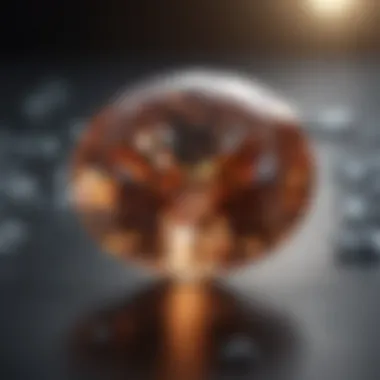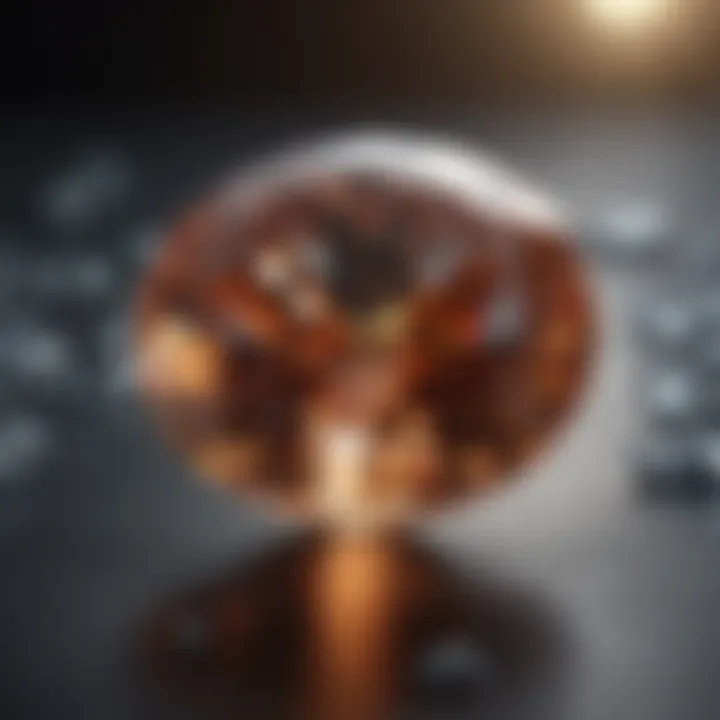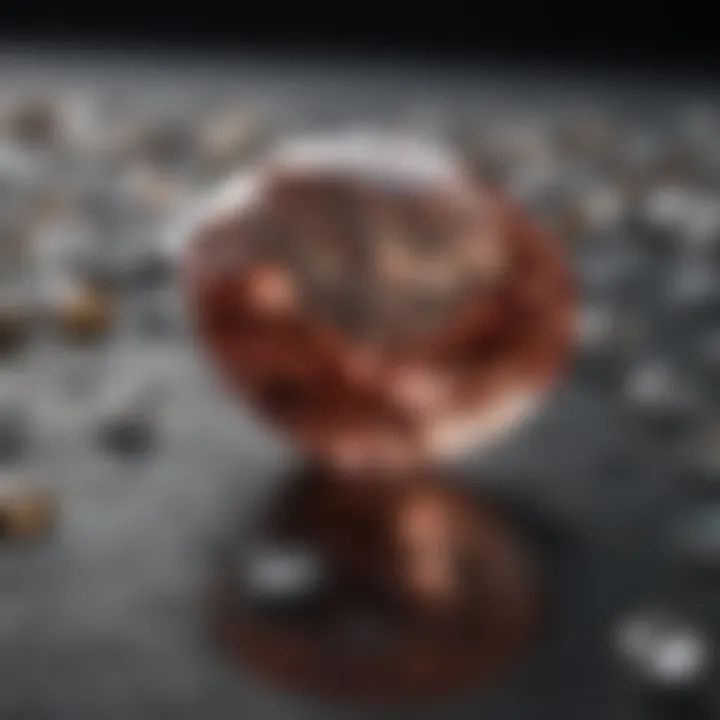Analyzing Bulk Diamonds: Origins, Value, and Trends


Intro
The world of gemstones is vast and intricate. Among these shimmering treasures, bulk diamonds occupy a prominent position, captivating a diverse audience—investors, collectors, and enthusiasts alike. To fully appreciate their significance, it's crucial to explore various facets, including their origins, grading, market dynamics, and the controversial ethics of sourcing. This article embarks on a journey into the depths of bulk diamonds, unraveling the complex tapestry that surrounds them.
Gemstone Overview
Definition of Gemstones
Gemstones are not just beautiful trinkets; they are a fascinating blend of science and art. Formed deep within the Earth under intense pressure and heat, these natural wonders can captivate anyone who lays eyes on them. In a nutshell, a gemstone is any precious or semi-precious stone that has been cut, polished, and utilized for adornment, investment, or collection. While diamonds steal the spotlight, many other gems like sapphires, rubies, and emeralds also share the stage.
Classification of Gemstones
Gems can be categorized in several manners, but the primary classification tends to focus on their composition and origin. Broadly speaking, these categories include:
- Precious Gems: Rarer and more valuable stones like diamonds, emeralds, rubies, and sapphires.
- Semi-Precious Gems: More common stones such as amethyst, aquamarine, and garnet.
Additionally, gemstones may be classified based on their geological origin or the method of production:
- Natural Gemstones: These stones are formed by natural geological processes.
- Synthetic Gemstones: Created in labs, replicating the composition of natural gems.
- Treatments: Many gems undergo processes to enhance their color or clarity, impacting their market value.
Historical Significance
Origins of Gemstone Use
The allure of gemstones dates back thousands of years. Historically, they have been seen not only as symbols of wealth and status but also as objects of power and mystical beliefs. Ancient civilizations often attributed various properties to stones, believing some could promote health, fortune, or protection. The earliest evidence of gemstones is found in ornaments and burial artifacts from cultures around the world.
Cultural Insights: Gemstones in Ancient Civilizations
In ancient Egypt, beautiful lapidary work was prominent, with gems like turquoise and carnelian favored for amulets. Similarly, the Romans treated gemstones as tokens of prestige, often wearing them in signet rings. Notably, diamonds were believed to possess protective qualities; it was thought that wearing them would ward off evil spirits. The old saying, "A diamond is forever," carries more weight than a mere marketing slogan; it echoes the timeless importance that these stones have held across generations.
"Gemstones have been not just adornments but also tokens of belief and tradition throughout history."
In sum, the historical journey of gemstones reflects humanity's evolving relationship with beauty, mystery, and value. As we continue examining bulk diamonds, understanding their significance through time feels vital to grasping their modern implications.
Preamble to Bulk Diamonds
When discussing bulk diamonds, it is crucial to understand not just what these gems are, but their significant role in the broader diamond industry. Bulk diamonds are often utilized in various applications ranging from industrial usage to speculative investment. They are fundamentally distinct from retail diamonds, which are typically sold to consumers in a polished and graded state for jewelry. Understanding the nuances of bulk diamonds can open doors to opportunities that some might overlook.
Definition and Characteristics
Bulk diamonds, in essence, refer to the unprocessed or minimally processed diamonds that are sold in larger quantities. Unlike their retail counterparts, bulk diamonds are not usually sold based on individual characteristics like cut or clarity. Instead, they are often traded based on volume, purity, and weight, making the conversation around them quite different.
Key characteristics of bulk diamonds include:
- Variety in Size: These diamonds can manifest in multiple sizes, directly impacting their sourcing and price.
- Lack of Cut and Polish: Most bulk diamonds do not undergo the extensive cutting and polishing processes, thus presenting a more rugged appearance compared to retail stones.
- Grading Factors: Although they may not possess the same detailed grading as retail diamonds, bulk diamonds are still assessed based on broad specifications such as clarity and carat weight.
Understanding these aspects is pivotal for anyone considering investment or collection of bulk diamonds.
Comparison with Retail Diamonds
The dichotomy between bulk diamonds and retail diamonds carries wide implications for buyers and investors alike. Retail diamonds are typically evaluated based on the Four Cs: Cut, Color, Clarity, and Carat weight, leading to a detailed pricing strategy that can leave potential sellers scrambling when bulk diamonds are examined through that lens. In contrast, bulk diamonds are generally more concerned with overall purity and volume rather than individual characteristics.
Some notable differences include:
- Market Access: Retail diamonds are marketed to consumers through jewelers, whereas bulk diamonds can be accessed through different channels, often requiring industry connections.
- Price Point: Bulk diamonds usually come at lower price points than retail diamonds of similar weight and characteristics, primarily because they are less refined.
- Usage Intent: Retail diamonds are mostly intended for adornment while bulk diamonds often find their way into industrial applications, advancing cutting tools and technological equipment.
In summary, comprehending the contrasts between bulk and retail diamonds allows for wiser investment choices and an informed understanding of their appraisal in the gemstones domain.
Historical Context
Understanding the historical context of bulk diamonds offers valuable perspective into their significance today. The journey of these gemstones spans centuries, revealing how they transitioned from rare finds to a widely traded resource. By grasping the evolution of diamond trade and cultural significance, enthusiasts and investors can appreciate the value and the deeper meanings associated with bulk diamonds.
The Evolution of Diamond Trade


Historically, diamonds were shrouded in mystique, often viewed as talismans of power and wealth. Their trade began as early as the 4th century BC, primarily in India. During this period, diamonds were gathered from riverbeds, and their incredible hardness was recognized. No one expected the small, sparkling stones to evolve into a global commodity.
As trade routes expanded, so did the accessibility and desirability of diamonds. The Middle Ages saw Europeans become increasingly fascinated with diamonds, viewing them as symbols of faith and devotion. This was a time when diamonds were often set in religious artifacts. It wasn't until the 19th century that diamonds began to be seen as the ultimate expression of romance and commitment, largely thanks to clever marketing strategies.
In the late 1800s, discoveries in South Africa fundamentally altered the diamond industry. The Kimberley mine became a significant site, giving rise to large-scale diamond mining operations. This era marked a shift from artisanal collection to industrial extraction, allowing diamonds to flood the market. Consequently, the dynamics of sourcing shifted dramatically, laying the groundwork for today’s market.
Today, the diamond trade operates on a global scale. Countries like Russia, Botswana, and Canada have emerged as key players, influencing supply and prices. The complexity of the gem market reflects a great deal about modern capitalism and how luxury commodities are interwoven with geopolitical factors. As this industry has grown, so have the standards and practices surrounding ethical sourcing and environmental impact.
Cultural Significance of Diamonds
Diamonds are more than just rocks; they hold profound cultural significance around the world. In many cultures, diamonds represent status and achievement, often given during monumental life events. For instance, engagement rings adorned with diamonds have become a staple in Western culture, symbolizing love and commitment.
In India, diamonds have a historical association with royalty and tradition. Here, diamonds are not just tokens of wealth but carry deep spiritual meanings. They are frequently used in religious ceremonies and are believed to bring good luck. The significance of diamonds transcends mere adornment; in various traditions, they serve as objects of worship.
Moreover, the portrayal of diamonds in literature and film has contributed to their allure and mystique. References to diamonds in popular culture often emphasize luxury and desire, further embedding them into the social fabric. This image appeals to collectors and investors alike, who view them as tangible assets worthy of investment.
"Diamonds are like the stories we tell ourselves. They reflect our deepest desires and aspirations, woven through history, culture, and personal meaning."
As bulk diamonds enter discussions of trade and economics, their storied past adds layers of complexity. Thus, understanding this context enhances our appreciation of these precious gemstones and informs informed decisions about investment and ethical considerations.
In essence, the deep history and cultural roots of diamonds not only shape their present-day value but also influence how they are perceived in personal and collective contexts. By comprehending these layers, gemstone enthusiasts and potential investors can better navigate the multifaceted world of diamonds.
Sourcing Bulk Diamonds
Understanding the sourcing of bulk diamonds is crucial for anyone involved in the gemstone industry. This is not just about where the diamonds come from, but also about how they're acquired and the practices surrounding those methods. The sources of bulk diamonds hold immense importance not only for investors and collectors but also for the ethical implications tied to their procurement.
Major Producers in the Industry
The diamond market is a tapestry woven from various hands and locations around the globe. Among the key players, countries like Russia, Botswana, and Canada stand out. Russia, for instance, remains the largest diamond producer in terms of carat weight and value, yielding millions of carats each year. Companies like Alrosa drive this powerhouse, continuing to influence global prices significantly.
On the other hand, Botswana has garnered a reputation for its high-quality diamonds. De Beers has had a long-standing relationship with this country, creating an economic framework that bolsters both the industry and local communities. The profit-sharing agreements and the establishment of local diamond cutting and polishing facilities have nurtured Botswana's economic growth in a way that few other countries can boast.
Then we have Canada, which has emerged as a significant producer relatively recently. Mines like the Ekati and Diavik produce exceptional stones that add a North American flavor to the diamond trade landscape. The differing sourcing methods in these regions sometimes reflect their local governance and socio-economic conditions.
Mining and Extraction Processes
When it comes to mining and extraction, the methods vary greatly across locations and types of mines. Most notably, mining occurs through two main techniques: open-pit mining and underground mining. Open-pit mining is often the most visible and involves removing large amounts of earth to reach the diamond-bearing rock. This process can be massive in scale, exposing the operations directly to environmental scrutiny.
In contrast, underground mining requires extensive tunneling to access diamonds lying deeper. This method is often more sustainable as it minimizes surface impact, yet carries its own risks and costs. The extraction process itself is meticulously studied due to its complexity and requirement for precision—diamonds are rare, and the profitable retrieval is vital for any operation's viability.
Innovations are constantly emerging, allowing mining companies to improve efficiencies in these processes. Technologies like automated mining and drone surveying are becoming commonplace, optimizing the methodologies used in diamond extraction.
Challenges in Sourcing
The challenges attached to sourcing bulk diamonds can't be brushed off easily. The diamond trade is often fraught with obstacles from various angles. First and foremost is the ethical sourcing of diamonds. Identifying conflict-free diamonds has become paramount as consumers increasingly demand transparency. Conflict diamonds, often referred to as “blood diamonds,” taint the industry with stories of human rights abuses.
Moreover, geological challenges don’t make matters easier. Not all diamond mines produce stones of equal quality; this variability poses risks to buyers and manufacturers alike. Thinking again about operational costs, this mining complexity can lead to price volatility and influence overall market dynamics.
- Environmental Regulations: Stricter regulations regarding environmental impacts complicate extraction processes. Companies must now balance profitability with sustainability.
- Market Oversupply: The increase in lab-grown diamonds has created another layer of challenges. While lab-grown stones offer ethical assurances, they can affect the pricing and perceived value of natural diamonds.
Lastly, fluctuations in global demand create a roller-coaster effect in the market. One minute the demand might skyrocket, and the next, it plummets, leaving producers scratching their heads over inventory and pricing strategies.
"The sourcing of bulk diamonds is a fine line to tread; it embodies more than mere acquisition but involves the moral fabric of the industry itself."
Sourcing bulk diamonds encompasses a world of intricacies that extend beyond raw material acquisition. Understanding the stakeholders, processes, and challenges at play not only equips stakeholders with knowledge but also fosters a deeper appreciation for these exquisite gemstones.
Grading and Classification
Grading and classification are vital components in understanding the world of bulk diamonds. These processes serve as the foundation for evaluating quality and determining marketability. When it comes down to it, the way diamonds are graded can dictate their value, desirability, and even their longevity in the market. Thus, comprehending the nuances of grading not only helps collectors and investors make informed decisions, but also deepens appreciation for these gemstones.
Understanding the Four Cs
Cut


The cut of a diamond refers primarily to how well it has been shaped and polished. This isn’t just about aesthetics; the cut impacts how light interacts with the stone. If a diamond is cut poorly, it can appear dull; however, a fantastic cut dazzles, exuding brilliance and fire. Collectors often seek well-cut diamonds because they maximize light return, leading to a stunning visual effect.
A unique feature of the cut is the ability to truly define the character of the diamond. Some might prefer a round brilliant cut, often lauded for its superior sparkle. Others might gravitate towards emerald or cushion cuts, which can lend a vintage charm. However, one must remember that certain cuts may not suit all tastes; what works for one might not sit right for another.
Color
The term color in diamonds primarily refers to the absence of color, with high-quality diamonds being nearly colorless. However, color grading does relate to a range that extends from completely colorless to noticeable shades. For bulk diamonds, maintaining near colorlessness is often seen as attractive. That’s why the G in the GIA color grading scale is often a desirable target for many sellers and buyers alike.
A special characteristic of color grading lies in its variation. Diamonds can showcase subtle differences that can affect their overall charm, making the selection process nuanced and fascinating. Yet, be mindful; too much color can detract from the diamond's appeal, especially for buyers after that classic look.
Clarity
Clarity assesses the presence of inclusions (internal flaws) and blemishes (external flaws). A diamond that holds fewer inclusions tends to fetch a better price. Clarity is classified from flawless to heavily included, often dramatically affecting market value. Therefore, collectors deep diving into bulk diamonds should take clarity into close consideration—it's often the fine details that can elevate beauty and buy-ability.
What stands out about clarity is its role in defining a diamond's uniqueness. Two diamonds can look nearly identical at first glance but might diverge in price because of detailed inspection. A good clarity ensures that the diamond shines not just from a distance but also up close—a vital selling point.
Carat Weight
Carat weight measures how much a diamond weighs. It's a straightforward grading metric, often misunderstood as one of the most important indicators of a diamond's price. Here’s where things get tricky; while larger carat weights typically elevate prices, they don't make for a diamond's inherent quality.
Uniquely, carat weight operates under the perception that bigger means better—this may be true but only to a particular extent. Some collectors may find smaller carats with exceptional quality more appealing, which opens the door for nuanced investments. Therefore, when engaging with bulk diamonds, don’t get swept away solely by weight; more isn't always merrier.
Certification Standards
In the sphere of diamond acquisition, certification guarantees authenticity. Renowned organizations like the Gemological Institute of America and the International Gemological Institute offer certifications that signify quality assurance. For a buyer or investor, certificates present needed assurance of a diamond's grading attributes.
The importance of certification cannot be overstated. A diamond with a proper certification can smooth the path for higher resale value, ensuring the owners feel secure with their investments. Undeniably, relying on trusted certifications helps in separating the wheat from the chaff when navigating through bulk diamonds.
Market Dynamics
Understanding the market dynamics of bulk diamonds is crucial for anyone involved in the gemstone industry—be it collectors, investors, or jewelry designers. The interplay of various elements like supply, demand, pricing, and consumer behavior shapes the landscape of this market. Knowing these factors can not only help make informed decisions but also unveil potential opportunities for investment.
Current Market Trends
Recent trends showcase a noticeable shift in how bulk diamonds are perceived and valued. One significant trend is the shift towards ethical mining practices, driven by consumer awareness. Buyers nowadays prefer transparency regarding the origins of their diamonds, demanding clarity on ethical sourcing. Companies that align with these values often enjoy a competitive edge in the marketplace.
Additionally, the popularity of online marketplaces is soaring. Consumers are increasingly purchasing diamonds through digital platforms, where they can compare prices and quality more effectively than in traditional retail settings. This evolution is making the bulk diamond market more accessible, allowing even newer collectors to dive into what was once a niche segment.
"Understanding trends is like reading the tea leaves; it helps predict future movements."
Price Fluctuations
Price fluctuations in the bulk diamond market can be unpredictable and influenced by numerous factors. The prices often rise and fall based on supply constraints, geopolitical tensions in major mining regions, and changes in market demand.
- Supply Issues: When mining operations face disruptions—be it from natural disasters or labor strikes—the ensuing supply shortage can drive prices higher.
- Demand Variances: Economic cycles also play a role. During booming economic times, the demand for luxury goods increases, subsequently nudging diamond prices up. Conversely, during economic downturns, prices may experience downward pressure due to lower consumer spending.
- Emerging Competition: With the rise of lab-grown diamonds, traditional diamonds may find their market value challenged, contributing to price volatility.
Impact of Lab-Grown Diamonds
Lab-grown diamonds are becoming a formidable player within the bulk diamond market. They offer a more affordable alternative without sacrificing quality, making them attractive to a younger demographic. This trend raises several considerations:
- Consumer Preferences: As awareness grows regarding sustainability, lab-grown diamonds are appealing to eco-conscious consumers. They often view these diamonds as a favorable choice, leading to shifting attitudes in purchasing behavior.
- Price Competition: The introduction of lab-grown diamonds may result in a drop in the market value of natural diamonds, forcing traditional dealers to adapt their strategies.
- Regulatory Scrutiny: As lab-grown options become more mainstream, questions surrounding their classification and marketing arise. Regulatory bodies may impose new guidelines, adding layers of complexity in how these diamonds are presented to consumers.
In essence, the multilayered market dynamics surrounding bulk diamonds is constantly evolving. For gemstone enthusiasts and collectors, staying abreast of these changes is critical for navigating this intriguing yet intricate industry.
Investment Potential
Understanding the investment potential of bulk diamonds is essential, especially for collectors and investors aiming to diversify their portfolios. This section delves into the nuanced aspects of bulk diamonds as an asset class, providing insights not just on their value, but also on the potential risks and benefits involved.
Diamonds as an Investment Vehicle
Bulk diamonds have carved out a niche as a viable investment option. Unlike other precious commodities, diamonds offer certain intrinsic qualities that can appeal to investors. For instance:
- Stability in Value: Diamonds have historically maintained their value over time, making them less prone to the wild fluctuations seen in more traditional markets like stocks or real estate.
- Scarcity and Rarity: High-quality diamonds, especially those with unique colors or characteristics, can fetch significant sums. Their limited availability adds an appeal for investors looking for something that could appreciate in value.
- Tangible Asset: Unlike digital currencies or stocks, a diamond is a physical asset. This tangibility may provide comfort to investors wary of virtual investments.


In recent years, some investors have opted to treat diamonds similarly to how art is viewed—by investing in pieces with particular historical or aesthetic significance. In this context, knowing how to evaluate diamonds based on the grading elements—cut, color, clarity, and carat weight—becomes invaluable for potential buyers.
As the market for diamonds evolves, investors might also consider partnerships with gem dealers or accessing auction houses, which can yield better pricing and unique buying opportunities.
Risk and Return Analysis
As with any investment, diving into bulk diamonds isn't without its risks. An informed analysis can help mitigate these concerns:
- Market Volatility: The diamond market, while generally stable, is not immune to economic downturns. During a recession, luxury items often see decreased demand. Investors need to be prepared for potential declines.
- Liquidity Issues: Unlike stocks, which can be sold within moments through various platforms, selling diamonds can take time, depending on market conditions and buyer interest. Therefore, investors might find themselves holding assets longer than anticipated.
- Price Manipulation: The diamond market can sometimes be opaque, allowing for the potential of price manipulation. Understanding market trends and having access to reliable appraisal services can counter this risk.
"Investing in diamonds requires patience and insight, much like fine wine; its true value often unfolds over time."
Ultimately, a thorough understanding of the diamond market is crucial. Investors must keep abreast of industry trends and remain cautious about pricing—being informed is key to navigating the intricate world of bulk diamonds for investment purposes.
Ethical Considerations
When it comes to bulk diamonds, the ethics surrounding their acquisition and sale cannot be overlooked. This section dives into the significant ethical considerations that inform the diamond industry, where transparency and integrity are paramount. Amidst the glitter and allure of diamonds, there's a moral dimension that has far-reaching implications, not just within the market but also for society at large. It's about ensuring that the stones on display in showcases around the world do not come at the expense of human rights or the environment.
Conflict Diamonds and Their Regulation
Conflict diamonds, or blood diamonds as they are often called, represent a dark chapter in the history of the diamond trade. These stones are mined in war zones and sold to finance armed conflict against governments, fueling violence and human rights abuses. The term itself evokes a sense of urgency and highlights the need for action. The Kimberley Process Certification Scheme was established in 2003 to tackle this issue. It aims to prevent the trade of conflict diamonds by ensuring that diamonds are sourced from legitimate and verified sources. Countries participating in the scheme must certify that their diamonds do not contribute to conflict, although the effectiveness of such regulations is frequently called into question.
The reality is that enforcing the measures set by the Kimberley Process can be a difficult task, especially in regions where governance is weak. Reports have surfaced about diamonds slipping through the cracks, finding their way to the consumer market under the guise of legitimacy. Therefore, it is essential for consumers and collectors to do their due diligence. Seeking diamonds that come with reputable certifications and knowing the source can help ensure that one is not inadvertently supporting violence and oppression.
"Consumers hold the power. Every diamond purchased is a testament to your values. Choose wisely."
Sustainable Sourcing Practices
Sustainability in the diamond industry is more than a buzzword; it’s a necessity. Sustainable sourcing practices aim to limit the environmental impact and promote ethical labor conditions in diamond mining. As awareness grows, a number of companies are making strides towards responsible sourcing. Practices such as using renewable energy in mining operations, reducing water usage, and implementing fair labor standards are becoming influential in shaping the future of the industry.
A notable example is the initiative by companies like De Beers, which have adopted sustainability measures that range from conservation efforts to community involvement in diamond mining regions. By investing in local communities, they aim to create job opportunities and improve living standards, which ultimately contributes to reducing the extraction of conflict diamonds.
However, not every company adheres to these practices. It's crucial for consumers to critically assess the brands from which they purchase diamonds. Asking questions about sourcing, labor practices, and environmental impact can illuminate whether a company is genuinely committed to sustainability or merely greenwashing its image.
The Role of Technology in the Diamond Industry
The intersection between diamond mining and technology represents a pivotal shift in the landscape of the diamond industry. As we delve into the role technology plays in the diamond sector, it's clear that advancements not only enhance efficiency but also aim for sustainability and ethical practices. This article aims to outline how technology is reshaping extraction processes and the marketplace, providing a fresh lens through which gemstone enthusiasts and investors can view the industry.
Innovations in Extraction and Processing
In the quest for more efficient and less environmentally invasive methods, the diamond industry has embraced various technological innovations. Traditional mining practices often come with substantial ecological footprints, but newer methods are beginning to change that narrative.
- Automated Mining Technologies: Today’s diamond mines are seeing a rise in the use of automated mining technologies. This can be seen in the use of autonomous trucks and drilling rigs. These machines not only reduce the need for human labor in hazardous environments but also optimize the extraction process, leading to faster and more precise digging.
- Sensor Technologies: Innovative sensor technologies are now in place to identify diamond deposits with greater accuracy. Utilizing geophysical methods like seismic surveys can help pinpoint where the diamonds are hiding under layers of rock and soil, making extraction much more efficient.
- Water Treatments: With the high water usage associated with diamond mining, advancements in water treatment technologies have emerged. Techniques that recycle and purify water used in mining processes promote responsible water management, helping reduce the strain on local ecosystems.
- Data Analytics and AI: The integration of big data analytics and artificial intelligence is transforming how companies analyze potential mining sites. Predictive modeling helps companies understand where to focus their efforts and reduces the time and resources spent on unproductive areas.
These innovations showcase a commitment to enhancing profitability while addressing environmental concerns. As the industry progresses, integrating technology with traditional practices could be the recipe for a sustainable future in diamond extraction.
Digital Marketplaces for Bulk Diamonds
The rise of digital marketplaces is revolutionizing the way bulk diamonds are traded. In an age where transparency and accessibility are paramount, online platforms are becoming the go-to for both consumers and vendors.
- Global Reach: Online platforms allow buyers and sellers to connect regardless of location. A jeweler in New York can transact with a miner in Africa, creating opportunities that just weren't feasible a couple of decades ago.
- Transparency in Pricing: Digital marketplaces offer clearer insights into pricing. Gone are the days when consumers were at the mercy of jewelers' markups. Detailed listings and comparisons empower buyers to make informed choices, as they can see variations in price and quality with just a few clicks.
- Verification and Certification: These online platforms often provide tools for verification of diamonds, ensuring that buyers know exactly what they’re purchasing. Advanced technologies like blockchain are making their mark in this realm, providing a transparent record of a diamond's provenance, which is vital to ethical sourcing.
- User Experience: Many of these digital environments are geared towards enhancing user experience. Intuitive interfaces, detailed product descriptions, and photographs help bridge the gap, making bulk diamonds more accessible to a larger audience, including collectors and jewelry designers.
Overall, the integration of technology into the diamond industry—from innovative extraction techniques to the proliferation of digital marketplaces—offers a dynamic shift. By enhancing efficiency, improving transparency, and promoting sustainable practices, technology is steering the diamond world toward a more promising and ethical future.
"The diamond industry stands at a pivotal moment where technology and traditional practices must harmonize for the betterment of people and planet."
As the market continues to evolve, witnessing the way technology shapes these practices provides not only insights but also opens doors for future innovations.
The End
In the realm of gemstones, bulk diamonds occupy a distinction that is often misunderstood. Their importance isn't just in their glitter or monetary value; they embody a complex interplay of market dynamics, ethical sourcing, and technological advancements. This article has sought to illuminate these facets, helping readers appreciate not only the sparkle but the story behind bulk diamonds.
Future Outlook for Bulk Diamonds
As we peer into the crystal ball regarding bulk diamonds, there are many factors at play. Market trends indicate a shift in consumer preferences, particularly among younger generations increasingly aware of ethical sourcing. Today’s consumers are more likely to seek diamonds that align with their values, favoring sustainable and conflict-free options. As a result, the industry is adapting, employing innovative methods to ensure that their diamond offerings are not only stunning but responsibly sourced.
Moreover, as technology advances, we may see greater efficiencies in mining and production, potentially altering the pricing structure. The advent of blockchain and digital marketplaces enhances transparency, giving buyers more confidence in their purchases. Ultimately, the future looks bright and multifaceted, with both challenges and opportunities presenting themselves at every turn.
Final Thoughts
In wrapping up this exploration, it’s clear that bulk diamonds hold more than just a place in the jewelry box; they are a testament to human ingenuity and the changing tides of ethical consciousness. Collectors and enthusiasts must remain vigilant, understanding how these variables shape the landscape of diamond ownership. The journey of a bulk diamond—from its source deep within the Earth to its final cut and polish—is fraught with considerations that go beyond mere beauty. We encourage those interested in this sparkling world to stay informed, adapting as the market shifts and evolves.
Ultimately, the allure of bulk diamonds continues, inviting those with a discerning eye to engage in a dialogue that is far richer than ornaments alone. Their story remains one of splendor intertwined with responsibility and innovation.



